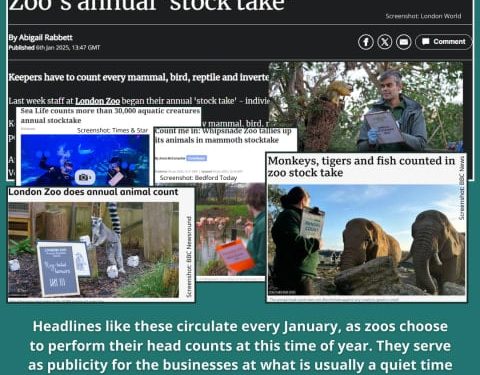14th January 2025
You may have noticed that, over the past week, stories have been hitting the national news about zoos and aquariums carrying out ‘stocktakes’. This is when staff count all of the animals they have in captivity and submit the number to the council responsible for licensing them. News coverage and zoos themselves often report this as a cute annual activity, showing pictures of penguins inspecting clipboards and elephants approaching the staff to see what’s going on. But, there’s more to this process than meets the eye.
Why do zoos and aquariums do stocktakes?
Every zoo and aquarium in the country is required to hold a zoo licence to operate, issued by their local council. As a part of that licensing process, they must submit an annual record of the number of animals they hold captive, separated by species and sex.
What does the council learn from stocktakes?
Although an annual stocktake might seem like a good way of keeping track of the population levels within a zoo or aquarium, this activity doesn’t show the whole picture. The council can see, for example, if the number of meerkats in a zoo has increased or decreased since last year. However, a lot of information may be lost in such a simple approach. For example, if two meerkats escaped that year, and one died from a preventable disease, but three were born at the zoo, the council will not be able to tell from the numbers that there is anything wrong, since the overall number of meerkats would remain the same. This is one of the ways that these counts fail to protect animals in captivity.
What do zoos learn from them?
Zoos often participate in international breeding programmes aimed at increasing the number of endangered species in captivity. On the face of it, this may seem like a worthwhile and noble pursuit. However, in practice this means families are torn apart so that individuals can be sent sometimes thousands of miles away to breed. The results of these breeding programmes do not benefit endangered wild populations, as offspring are almost never reintroduced to the wild. The real result of captive breeding programmes is cute, rare, baby animals that zoos can use to market their attraction to visitors.
What can the public learn from them?
London Zoo alone counts over 10,000 animals each year. Sea Life Aquariums hold over 30,000 individuals captive. Each of these tens of thousands of animals recorded on these clipboards across the country is an individual destined to spend their entire life in a cage or a tank. The sheer scale of this misery is heartbreaking. What makes stocktakes even more outrageous is the disrespect shown to these animals by referring to them as ‘stock’, as though they are items in a warehouse from which a business can profit.
Because that’s exactly what zoos and aquariums use animals for – profit. This is the most important lesson we can learn from these stocktakes, and one that is never reported in the whimsical news stories published at this time of year.
What needs to change?
For a long time, Freedom for Animals has been campaigning for greater transparency in zoos and aquariums. We want access to much more information about what they get up to behind closed doors. This means replacing the simple annual headcount with reporting on births, deaths, escapes, medical interventions, and trades with other zoos. This information being collected and made public would demonstrate the scale of an industry that trades in exploitation and misery. And, we believe, the public would finally turn their backs on these attractions if the truth were exposed.
How you can help!
We are asking DEFRA to overhaul the licensing system and change the reporting system to make more information accessible to the public. Use the form on our website to add your voice to this call.









Discussion about this post